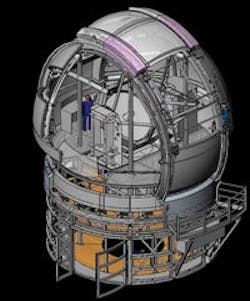ASTRONOMY: Rocky Planet Finder Telescope to search for exoplanets

The new Rocky Planet Finder Telescope (RPFT; also known as the Automated Planet Finder) at the UCO/Lick Observatory (Mt. Hamilton, CA) is expected to begin searching for extrasolar planets this fall, according to Steve Vogt, professor of astronomy and astrophysics at University of California, Santa Cruz (UCSC) and an astronomer at UCO/Lick, which is run by UCSC. Funded by the U.S. Department of Defense ($6 million) and NASA Jet Propulsion Laboratory ($2 million), construction on the 2.4-m automated telescope began just last fall but has progressed ahead of schedule, Vogt says, meaning the telescope should come on line just 11 months after initial ground-breaking.
Several things set the RPFT apart from other Earth-based telescopes such as the W.M. Keck Observatory in Hawaii and the Very Large Telescope in Chile. For one thing, unlike public telescopes that provide shared usage limited to less than 20 nights per year per project, the RPFT will be dedicated 365 nights per year to planet hunting. The RPFT telescope and spectrograph, used nightly without alteration, will enable a Doppler precision of 1 m/s. The new telescope will target nearby stars and observe them every night for months to detect the lowest possible Doppler wobble, and hence the lowest possible planet mass. The advantage of this for exoplanet research is significant, according to Vogt.
The only thing standing in the way of finding an Earth-size planet around a low-mass star is consistent telescope access, he notes. “This is hard because our big telescopes are public facilities and lots of scientists are standing in line to use them so we do not have the opportunity to use them night after night,” he says. “This is why the Automated Planet Finder was born. It will be ours and we can use it 365 nights a year.”
Detecting small changes in star’s velocity
The RPFT is designed to target a preprogrammed list of a few dozen nearby stars (out of a 1300-star sample) and observe them every night for months, using a high-resolution echelle spectrometer and radial velocity optimized for the Doppler detection of planets that have masses five to 20 times that of Earth. By tracking the stars’ motions, Vogt and his colleagues hope to find planets that are rocky, have atmospheres, and can retain water (like Earth), which means they may be able to sustain life (to date, most of the 180 exoplanets identified by astronomers are Jupiter- and Neptune-size gas-based masses). The spectrometer is designed to detect very small changes in each star’s velocity; the instrument’s ability to detect the smallest possible velocity changes means that planets of lowest possible mass can be detected. Spectrographic data will then be fed into an exoplanet data pipeline, which astronomers will then analyze to discover new planets. (For more on the search for exoplanets, see p. 85.)
According to Vogt, who designed the spectrometer, the instrument is optimized for efficiency and radial-velocity precision. It uses a fully dioptric f/3 collimator/camera-lens system feeding an R-4 echelle in near-littrow configuration. According to Vogt, the 8-in. collimated beam size is quite large for a telescope of this size, resulting in a generous throughput of 110,000 arcsec. Thus, even in moderate-quality seeing at a typical spectral resolution of 80,000, light loss at the slit will be minimal. In fact, the spectrometer is expected to achieve 35% efficiency and overall system efficiency is expected to reach 24%. According to UCSC, the key to this speed and precision come from the fact that the secondary obscuration is small and protected silver coatings are used on the secondary and tertiary mirrors. The optical train includes an atmospheric dispersion compensator (to stabilize the image against variable dispersion caused by changing zenith distance) and an iodine cell for radial-velocity reference.
“There is no imaging at all,” Vogt says. “We will just be tracking the periodic motion of the star. It’s like the star and planet are on a see-saw; you can’t see the little kid (the planet) but you can see the fat kid (the star). So we will be watching the fat kid wobble.”
About the Author
Kathy Kincade
Contributing Editor
Kathy Kincade is the founding editor of BioOptics World and a veteran reporter on optical technologies for biomedicine. She also served as the editor-in-chief of DrBicuspid.com, a web portal for dental professionals.